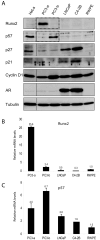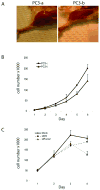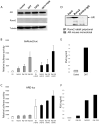The cancer-related Runx2 protein enhances cell growth and responses to androgen and TGFbeta in prostate cancer cells
- PMID: 20082326
- PMCID: PMC2925394
- DOI: 10.1002/jcb.22463
The cancer-related Runx2 protein enhances cell growth and responses to androgen and TGFbeta in prostate cancer cells
Abstract
Prostate cancer cells often metastasize to bone where osteolytic lesions are formed. Runx2 is an essential transcription factor for bone formation and suppresses cell growth in normal osteoblasts but may function as an oncogenic factor in solid tumors (e.g., breast, prostate). Here, we addressed whether Runx2 is linked to steroid hormone and growth factor signaling, which controls prostate cancer cell growth. Protein expression profiling of prostate cell lines (i.e., PC3, LNCaP, RWPE) treated with 5alpha-dihydrotestosterone (DHT) or tumor growth factor beta (TGFbeta) revealed modulations in selected cyclins, cyclin-dependent kinases (CDKs), and CDK inhibitors that are generally consistent with mitogenic responses. Endogenous elevation of Runx2 and diminished p57 protein levels in PC3 cells are associated with faster proliferation in vitro and development of larger tumors upon xenografting these cells in bone in vivo. To examine whether TGFbeta or DHT signaling modulates the transcriptional activity of Runx2 and vice versa, we performed luciferase reporter assays. In PC3 cells that express TGFbetaRII, TGFbeta and Runx2 synergize to increase transcription of synthetic promoters. In LNCaP cells that are DHT responsive, Runx2 stimulates the androgen receptor (AR) responsive expression of the prostate-specific marker PSA, perhaps facilitated by formation of a complex with AR. Our data suggest that Runx2 is mechanistically linked to TGFbeta and androgen responsive pathways that support prostate cancer cell growth.
(c) 2010 Wiley-Liss, Inc.
Figures





Similar articles
-
TGF-beta signaling and androgen receptor status determine apoptotic cross-talk in human prostate cancer cells.Prostate. 2008 Feb 15;68(3):287-95. doi: 10.1002/pros.20698. Prostate. 2008. PMID: 18163430
-
Androgen receptor and TGFbeta1/Smad signaling are mutually inhibitory in prostate cancer.Eur Urol. 2005 Dec;48(6):1051-8. doi: 10.1016/j.eururo.2005.09.006. Epub 2005 Oct 14. Eur Urol. 2005. PMID: 16257107
-
Androgen up-regulates epidermal growth factor receptor expression and binding affinity in PC3 cell lines expressing the human androgen receptor.Cancer Res. 1995 Jul 15;55(14):3197-203. Cancer Res. 1995. PMID: 7606741
-
Attenuation of androgenic regulation by brefeldin A in androgen-responsive prostate cancer cells.Urol Oncol. 2013 Jan;31(1):104-9. doi: 10.1016/j.urolonc.2010.11.009. Epub 2011 Jul 27. Urol Oncol. 2013. PMID: 21795077
-
Estrogen-TGFbeta cross-talk in bone and other cell types: role of TIEG, Runx2, and other transcription factors.J Cell Biochem. 2008 Feb 1;103(2):383-92. doi: 10.1002/jcb.21425. J Cell Biochem. 2008. PMID: 17541956 Free PMC article. Review.
Cited by
-
Identification of sequence-specific interactions of the CD44-intracellular domain with RUNX2 in the transcription of matrix metalloprotease-9 in human prostate cancer cells.Cancer Drug Resist. 2020 3rd Quarter;3(3):586-602. doi: 10.20517/cdr.2020.21. Epub 2020 Aug 21. Cancer Drug Resist. 2020. PMID: 33062960 Free PMC article.
-
Runx2 isoform I controls a panel of proinvasive genes driving aggressiveness of papillary thyroid carcinomas.J Clin Endocrinol Metab. 2012 Oct;97(10):E2006-15. doi: 10.1210/jc.2012-1903. Epub 2012 Jul 20. J Clin Endocrinol Metab. 2012. PMID: 22821892 Free PMC article.
-
Integrin αvβ3 and CD44 pathways in metastatic prostate cancer cells support osteoclastogenesis via a Runx2/Smad 5/receptor activator of NF-κB ligand signaling axis.Mol Cancer. 2012 Sep 11;11:66. doi: 10.1186/1476-4598-11-66. Mol Cancer. 2012. PMID: 22966907 Free PMC article.
-
Metastatic bone disease: role of transcription factors and future targets.Bone. 2011 Jan;48(1):30-6. doi: 10.1016/j.bone.2010.05.035. Epub 2010 Jun 1. Bone. 2011. PMID: 20561908 Free PMC article. Review.
-
The Role of RUNX2 in Osteosarcoma Oncogenesis.Sarcoma. 2011;2011:282745. doi: 10.1155/2011/282745. Epub 2010 Dec 9. Sarcoma. 2011. PMID: 21197465 Free PMC article.
References
-
- Afzal F, Pratap J, Ito K, Ito Y, Stein JL, van Wijnen AJ, Stein GS, Lian JB, Javed A. Smad function and intranuclear targeting share a Runx2 motif required for osteogenic lineage induction and BMP2 responsive transcription. J Cell Physiol. 2005;204:63–72. - PubMed
-
- Akech J, Wixted JJ, Bedard K, van der Deen M, Hussain S, Guise TA, van Wijnen A, Stein JL, Languino LR, Altieri DC, Pratap J, Keller E, Stein GS, Lian JB. Runx2 association with progression of prostate cancer in patients: mechanisms mediating bone osteolysis and osteoblastic metastatic lesions. Oncogene. 2009 Epub ahead of print. - PMC - PubMed
-
- Barnes GL, Hebert KE, Kamal M, Javed A, Einhorn TA, Lian JB, Stein GS, Gerstenfeld LC. Fidelity of Runx2 activity in breast cancer cells is required for the generation of metastases associated osteolytic disease. Cancer Res. 2004;64:4506–4513. - PubMed
-
- Bello D, Webber MM, Kleinman HK, Wartinger DD, Rhim JS. Androgen responsive adult human prostatic epithelial cell lines immortalized by human papillomavirus 18. Carcinogenesis. 1997;18:1215–1223. - PubMed
Publication types
MeSH terms
Substances
Grants and funding
- R01 CA078810/CA/NCI NIH HHS/United States
- P01 AR048818/AR/NIAMS NIH HHS/United States
- CA090917/CA/NCI NIH HHS/United States
- CA078810/CA/NCI NIH HHS/United States
- R01 CA109874/CA/NCI NIH HHS/United States
- R01 AR049069/AR/NIAMS NIH HHS/United States
- HL054131/HL/NHLBI NIH HHS/United States
- AR048818/AR/NIAMS NIH HHS/United States
- R01 CA090917/CA/NCI NIH HHS/United States
- DK032520/DK/NIDDK NIH HHS/United States
- R01 AR039588/AR/NIAMS NIH HHS/United States
- R37 HL054131/HL/NHLBI NIH HHS/United States
- CA082834/CA/NCI NIH HHS/United States
- P01 CA082834/CA/NCI NIH HHS/United States
- R01 HL054131/HL/NHLBI NIH HHS/United States
LinkOut - more resources
Full Text Sources
Medical
Research Materials
Miscellaneous

